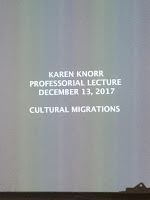V&A Museum of Childhood, London
Situated in Bethnal Green, this fascinating museum is a delight for both children and adults; it's transportive qualities connect visitors with memories of childhood and play. The richness and variety of the displays held my attention and my research lead me straight to Rachel Whiteread's installation "Place (Village)" (2006-2008). This community of vintage doll houses was collected by the artist over a period of twenty years and assembled in a stepped configuration to resemble a hilltop village. Each house is internally lit, and their emptiness evokes a haunted, mysterious and melancholic quality reminiscent in the artist's large sculptural works. They are a trace memory of a physical materiality diminished by time. Absence hangs heavily.
My attention was also drawn to the strange dolls and puppets held in the collection. The top right image is a 1946 glove puppet modelled on a burglar and was used in a comedy sketch performed by award winning puppeteer Mary Bligh-Bond. The puppet is constructed from plaster and textiles and his characterful features carefully detail expression and stance. These are elements I am concerned with to create and animate my puppets.
 |
| Place (Village), 2006-2008 Rachel Whiteread V&A Museum of Childhood |
In Kenneth Gross' (2011) essay on uncanny life, he states:
"The puppet creates delight and fear. It may evoke the innocent play of childhood or become a tool of ritual magic, able to negotiate with ghosts and gods. Puppets can be creepy things, secretive, inanimate while also full of spirit, alive with gesture and voice." (2011:01)
 |
| Mammets (Family), 2018, Sara Jayne Harris |
 |
| Mammets (George, Gilbert), 2018 Sara Jayne Harris |
 |
| Javanese rod puppet, C19th |
Paul Klee Puppets
http://www.differencebetween.info/difference-between-puppet-doll-and-toy
https://en.wiktionary.org/wiki/mammet
Gross, K. (2011) Puppet: An Essay on Uncanny Life. London: The University of Chicago Press Ltd.









Comments
Post a Comment